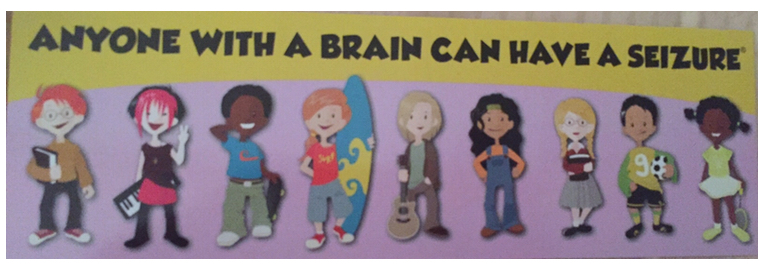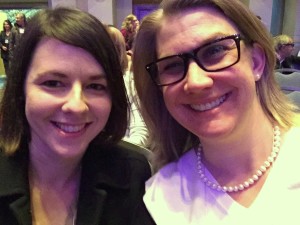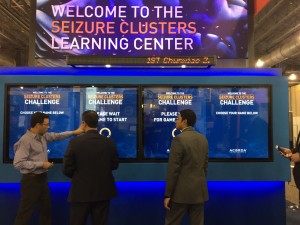Speak until somebody listens. And don’t stop there!
The annual meeting of the American Epilepsy Society was a success! AES 2015 was a time of reconnecting face-to-face with several individuals, organizations and doctors we now call friends. Professional and personal conversations revived the “HOPE” we all carry with us each day!
My personal highlights from this trip:
- Meeting Madhu (the grad student with Dr. Jensen’s laboratory) who is conducting her thesis project on CDKL5 Disorder.
- Updating Dr. Jensen and her laboratory crew on Harper’s progress as well as hearing from them how research is moving forward in their lab.
- Finding two potential metabolic doctors who are possibly willing to look at CDKL5 Disorder
- Sharing the fine line of Hope and Hopelessness many of us walk daily with AES in a video montage.
- Experiencing a virtual seizure through the eyes of Jane.
These meetings are very intense and emotional for a parent of a child who suffers daily because of Epilepsy. There is information overload in medical terminology, which should be worth foreign language credit in my personal opinion 😉
CDKL5 research, and the heart of it
(left photo) Me with two of Dr. Jensen’s laboratory scientists, including Madhu (far right)
Madhu, like many studying in the medical field, and especially in laboratory research, have somewhat of an emotional disconnect. And that’s okay! Meeting with me helped her understand that when she studies CDKL5, she is impacting Harper. Harper and all the others that will benefit from Madhu’s research need to be the face of her study. Our time together will now hopefully drive Madhu to understand the real people behind CDKL5 and any other disorder or disease she may choose to study in the future.
Hope4Harper CDKL5 Research Progress
Research requires equipment. Equipment costs money. And to get valuable data you need the right equipment. Dustin and I were so very proud to not only meet the individual whose thesis was impacted by our small-but-growing nonprofit, but also very excited to hear that funds raised by Hope4Harper were able to provide Madhu and Dr. Jensen’s laboratory with a very valuable piece of research equipment. This equipment is necessary to reduce error in seizure detection of specimens being used to collect valuable seizure data. This is a long-term benefit of your contributions to Hope4Harper and Epilepsy research.
CDKL5 and Metabolism: the potential for new research
Lectures, Special Interest Groups, Round Table Discussions, Investigators Workshops, Research Symposiums, Poster Sessions, Scientific Exhibits, Skills Workshops…
You have to balance or you can, like me, experience information overload and emotional exhaustion. The conference started at 7am each day and ran until 9pm each night for those trying to attend it all. I comb through what I feel is most important for my understanding and for those following and supporting Hope4Harper. Sharing this information with you is my privilege. I posted instant updates on Harper’s Facebook page as I worked my way through each portion.
One very exciting session for me was on Saturday titled “Energy Metabolism and Dynamic Brain States.” At the end of the session, we may have found potentially two metabolic doctors who may be willing to evaluate CDKL5 metabolic information we have collected. After I think four years of trying to be heard, someone may actually organize our data to find or rule out a connection between metabolism and CDKL5 seizure activity.
Sharing hope to relieve the hopelessness
There are several non-profit organizations of rare disorders represented at the American Epilepsy Society conference, many of which are part of the Epilepsy Leadership Council for the AES. Sometimes even though you know you are not alone you still feel alone.
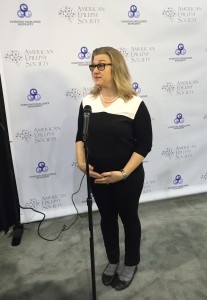 (left photo) Speaking about our nonprofit Hope4Harper
(left photo) Speaking about our nonprofit Hope4Harper
It’s hard to express how the simplest of tasks in daily living can become nerve wracking and lead to an emotional break down. Example: changing the diaper of a growing young girl and trying to get just ONE wipe at a time to come out of the package, only to have a clump of the sheets come out like a paper towel roll with no separation, all while trying to keep from making a mess everywhere then essentially flinging the entire pack of necessary wipes halfway across the room attempting to break the string of wipes apart. And you now have only one wipe in your hand for a mess of a large child and no way of reaching the pack of wipes you had just inadvertently flung across the room. Take a deep breath. For those of you that live this, you are now laughing from experience.
For those of you trying to understand how such a simple task could lead to an adult meltdown it’s because very simply: nothing about special needs is easy. We are tired, we worry, we love, we try! Some things in life should be easy, like pulling a wipe from a wipes container and when that alone becomes another added chore we sometimes just lose it!
Being able to connect, hug and converse with others living a similar life helps to bring you back to the side hope on that fine line we walk daily.
Virtual reality seizure
I remember when Dustin and I first discovered our newborn Harper was having seizures. Later we were in her Neurologist’s office reading posters about Epilepsy on the wall. We looked at one another and said, “Well at least she doesn’t have Epilepsy.” How uneducated we were.
In trying to explain the experience of living with a child with Epilepsy we say it’s like watching your child, through no fault of her own, being randomly electrocuted. And there is no plug to pull to turn it off. Understanding how that period of electrocution impacts a person I could only speculate about until now.
 (left photo) Me with Jane. It was her seizure that I experienced virtually.
(left photo) Me with Jane. It was her seizure that I experienced virtually.
A young woman, Jane, was attacked while riding her bike and suffered serious brain injury which led to Epilepsy. She has worked to create a virtual experience in order to share with others what it’s like to have a seizure. This virtual seizure experience was shared with everyone in Innovation Pavilion E at the 2015 American Epilepsy Society Conference.
Confusion, Weakness, Disorientation, Embarrassment
It’s a virtual experience I cannot do justice to in trying to explain it. It starts with Jane in a restaurant. She experiences a change in smell; she slowly begins to find it hard to focus, she blames it on needing something to eat or drink. She has trouble communicating what she needs, she’s not sure anymore where she is but externally blames her need for food or drink.
She blanks out and the seizure begins…the electric activity of circuits going haywire.
After an unknown amount of time she reappears with visual awareness but mental capacity can take a half hour to two hours to recover. She explains that to the common public she can actually appear fine once the seizure itself is over. But in reality when she actually becomes coherent she has no idea how she got to where she is or what activity she participated in after she went blank from the seizure itself.
This made me realize that Harper may have a seizure in the living room while watching a movie with sister or being held by Daddy. When the initial episode is over and she appears to be awake but she may not actually become fully coherent until two hours later when we are in the car, or bed, or taking a bath. She might be thinking, “How did we get here? What happened to the movie?”
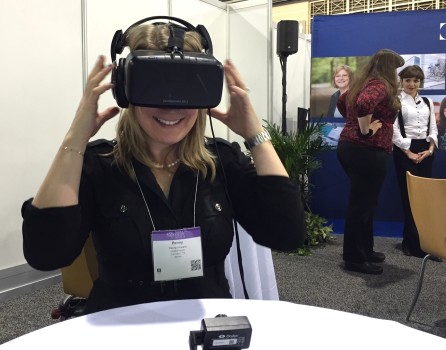
I wanted to take off the goggles. I couldn’t emotionally handle it. But I forced myself to continue because Harper cannot take off goggles. She suffers as do many others and even if only for a brief moment I will suffer for them to better understand them. I was a wreck by the end and totally embarrassed for my emotional reaction. Jane said her friend Michael had a very similar reaction and her mother refuses to see it. I composed myself, took a picture with Jane and left with a better understanding of my child and my friends with epilepsy. This is My Epilepsy Story!
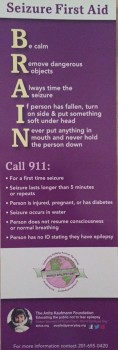
Before children, Dustin and I had pets. We rescued an older boxer we called Lady Bug. After a year or so with us she began to have seizures. After a seizure she would pace and pace around the house bumping into things. We would have to lead her into the back yard and let her just wander around for an hour before she would finally be able to come in and lay down. We never understood this and often wondered how her after-seizure impact was so very different from Harper’s. Now we see how they might actually be very similar. It’s just that Harper is immobile and non-verbal. Harper’s mind and vision and mental coherency may not actually return until one to two hours after an episode. Learning this truth does not truly establish my understanding of what a seizure is like. However, being able to virtually experience it I can now be much more sensitive to Harper during her recovery period.
I now have a better understanding of Harper herself and what she experiences. With this new knowledge I will build a better connection with each of my children and facilitate a better connection between them.
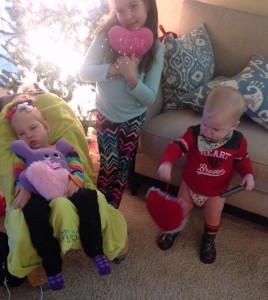
At the conclusion of AES 2015 I have more confidence to continue to move forward with opportunities surrounding Hope4Harper’s existence as a non-profit organization. I also intend to grow and collaborate more with other non-profits in 2016.
A moment to relax
Although this was a working trip, I took some time to enjoy and rejuvenate myself by getting some much needed rest without having to wake up to the responsibility of caring for children and maintaining a home. I visited a Christmas Village and enjoyed some Philadelphia sights.
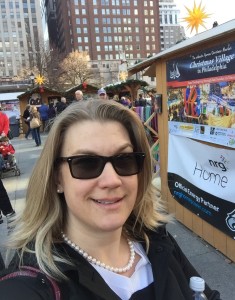

During one of my breaks I turned on the television without worry of kid appropriateness and caught the tail end of “A Brief Moment in Time.” I was struck by a statement we should remember and live by:
“However bad life may seem, there is always something you can do, and succeed at. While there’s life, there is hope.”

